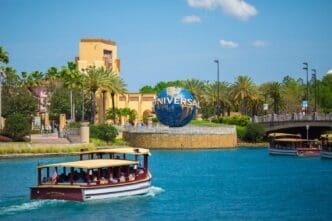Miami and South Florida have long been regarded as popular tourist destinations, attracting millions of visitors each year. The picturesque beaches, vibrant nightlife, and diverse cultural scene make this region an irresistible choice for travelers from all over the world. However, the surge in tourism has had both positive and negative impacts on the environment. In this blog post, we will analyze the relationship between tourism and the environment in Miami and South Florida.
 Tourists kayaking on the river of Islamorada, Florida Keys – Photo by Maridav / Shutterstock.com
Tourists kayaking on the river of Islamorada, Florida Keys – Photo by Maridav / Shutterstock.com
One of the most significant benefits of tourism in the region is the boost it provides to the local economy. The tourism industry generates billions of dollars in revenue each year, creating jobs, increasing the tax base, and supporting local businesses. This influx of money helps to fund essential infrastructure projects, such as improving transportation networks, maintaining beaches, and upgrading facilities. Consequently, the tourism industry plays a vital role in the economic development of Miami and South Florida.
However, the environmental consequences of this massive influx of tourists must also be considered. One of the most visible impacts is the strain on natural resources, particularly water and energy. The increased demand for water, especially during peak tourist seasons, puts pressure on the already dwindling freshwater reserves in the region. South Florida is heavily reliant on groundwater, which is essential for both tourism and the local population. Overuse of water resources can lead to saltwater intrusion, depleting underground reserves and endangering fragile ecosystems.
Furthermore, the energy consumption associated with accommodating and entertaining tourists contributes to greenhouse gas emissions and air pollution. Hotels, resorts, and transportation services require significant amounts of energy, often derived from fossil fuels. This not only contributes to climate change but also affects air quality, posing health risks for both residents and tourists.
Aside from natural resources and energy, another critical aspect to consider is the impact of tourism on the local ecosystem and biodiversity. Miami and South Florida are home to numerous unique and fragile ecosystems, including the Everglades and the coral reefs off the coast. These ecosystems provide essential habitat for a wide variety of plants and animals, many of which are already threatened or endangered. The constant influx of tourists, recreational activities, and development projects can disrupt these delicate ecosystems, leading to loss of biodiversity and long-term ecological damage.
To mitigate these negative impacts, local authorities and stakeholders have taken numerous measures to promote sustainable tourism practices. For instance, eco-tourism initiatives have gained popularity, focusing on highlighting the natural beauty and biodiversity of the region while minimizing negative environmental impacts. Additionally, stricter regulations have been put in place to monitor and control water consumption, waste management, and energy usage in hotels and resorts.
Education and awareness campaigns have also played a significant role in enlightening tourists about the importance of preserving the environment. Engaging visitors in eco-friendly activities, such as reef conservation programs, mangrove restoration projects, and responsible wildlife encounters, not only ensures the protection of the environment but also enhances the tourist experience by fostering a deeper connection with nature.
The bottom line is, the relationship between tourism and the environment in Miami and South Florida is complex and multifaceted. While tourism brings undeniable economic benefits, it also puts tremendous strain on natural resources, contributes to climate change, and threatens fragile ecosystems. However, through sustainable practices, education, and responsible tourism initiatives, steps can be taken to mitigate these negative impacts and ensure the long-term preservation of the region’s environment. By maintaining a balance between tourism and environmental conservation, Miami and South Florida can continue to thrive as a world-class destination while protecting its natural treasures for future generations.








